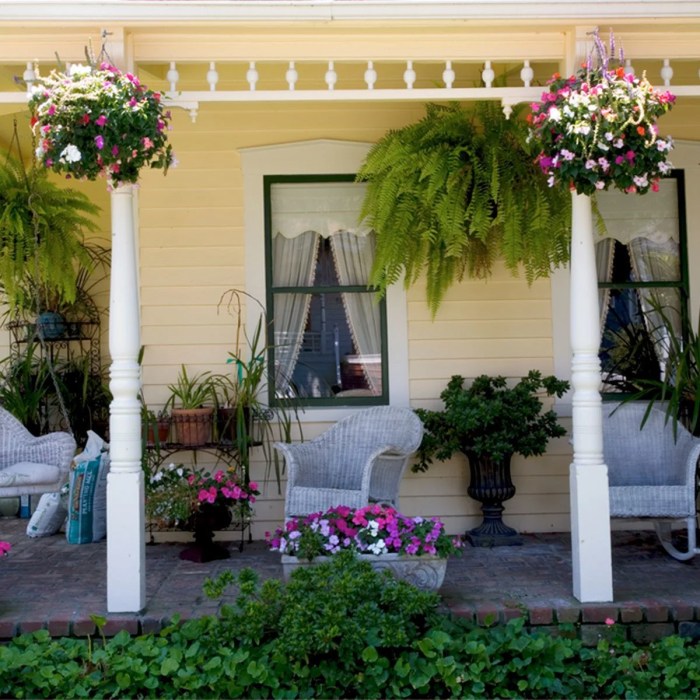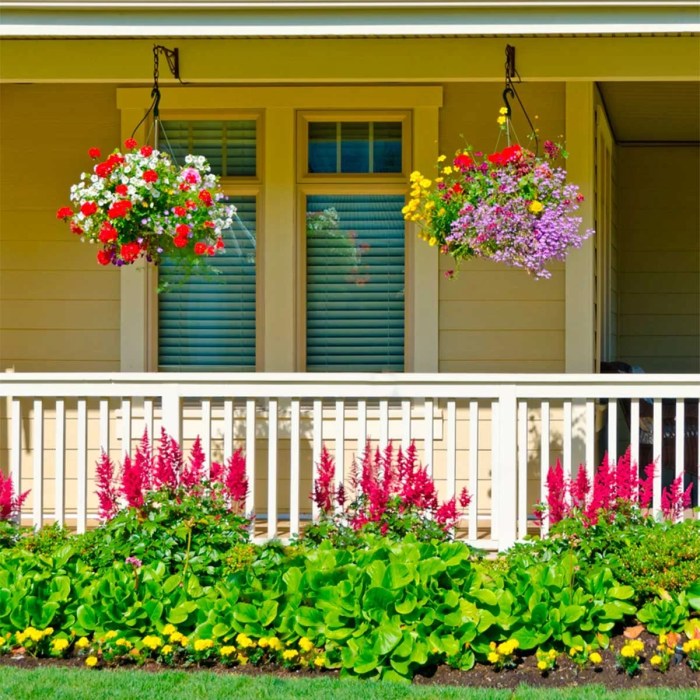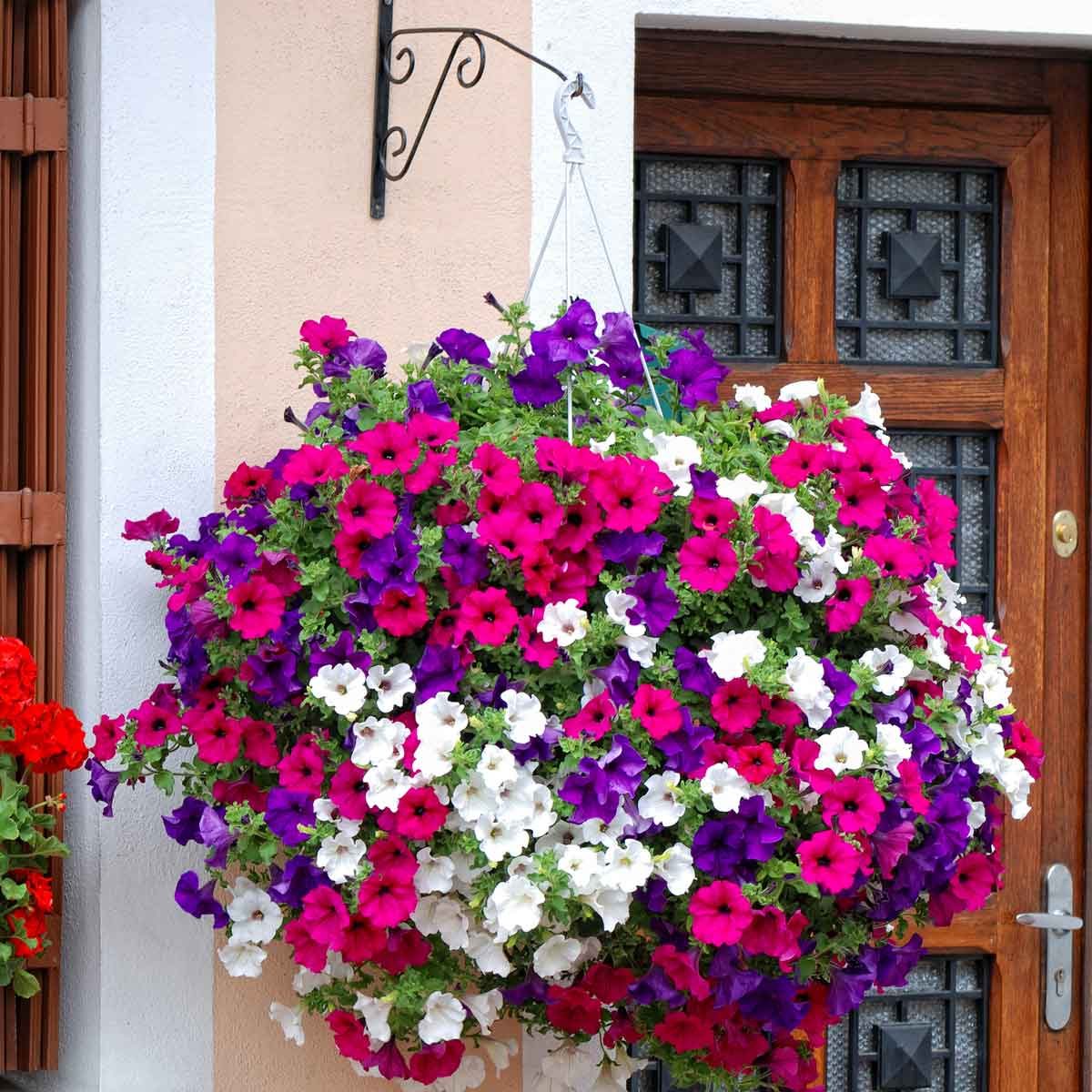Hanging plants for porch are a fantastic way to add life, color, and texture to your outdoor space. Whether you have a small porch or a large one, there are many different types of hanging plants that can add beauty and interest to your home.
In this guide, we will discuss the most popular hanging plants for porches, how to choose the right ones for your space, and how to care for them.
Hanging plants can be a great way to add some extra greenery to your porch without taking up too much space. They can also help to create a more inviting and relaxing atmosphere.
Popular Hanging Plants for Porches

When selecting hanging plants for your porch, consider sunlight exposure, maintenance requirements, and aesthetic appeal. Some of the most popular options include:
- Trailing Petunias: Abundant blooms in various colors; require regular watering and fertilization.
- Trailing Geraniums: Vibrant blooms; tolerate heat and drought but may need protection from excessive rain.
- Fuchsia: Delicate flowers with contrasting colors; prefer partial shade and regular watering.
- Lantana: Clusters of colorful blooms; attract butterflies and hummingbirds; can be invasive in some areas.
- Begonia: Shade-loving plants with large, showy leaves and delicate blooms; require consistent moisture.
- Spider Plant: Easy-care plants with long, arching leaves; produce plantlets that can be propagated.
- String of Pearls: Unique succulent with cascading stems resembling strings of pearls; prefers bright, indirect light.
- Air Plants: Epiphytic plants that absorb nutrients from the air; require high humidity and indirect light.
Choosing the Right Hanging Plants for Your Porch

Selecting the right hanging plants for your porch requires careful consideration of several factors. These include the amount of sunlight the porch receives, the desired aesthetic, and the level of maintenance you are willing to undertake. Additionally, the size and shape of the plants should be proportionate to the size of the porch and the available hanging structures.
Factors to Consider
- Sunlight:Choose plants that thrive in the amount of sunlight your porch receives. For sunny porches, consider sun-loving plants like geraniums, lantana, or petunias. For shady porches, opt for shade-tolerant plants like ferns, begonias, or impatiens.
- Aesthetics:Consider the desired aesthetic for your porch. Do you prefer lush, trailing plants like ivy or cascading petunias? Or do you prefer more structured plants like succulents or topiaries?
- Maintenance:Hanging plants require varying levels of maintenance. Some plants, like succulents, require minimal watering and care. Others, like ferns, may require more frequent watering and misting.
- Size and Shape:The size and shape of the plants should be proportionate to the size of the porch and the available hanging structures. Larger porches can accommodate larger plants, while smaller porches may be better suited for smaller plants or hanging baskets.
Creative Display Ideas for Hanging Plants on Porches

Enhance the aesthetic appeal of your porch by incorporating hanging plants. Embrace creativity and explore various display techniques to showcase your botanical wonders.
Experiment with macrame hangers, known for their intricate knots and bohemian flair. These hangers add texture and visual interest while securely suspending plants from the ceiling or beams.
Hanging plants can add a touch of greenery and elegance to any porch. If your porch receives limited sunlight, you’ll want to choose plants that can tolerate shade. Some popular hanging plants that like shade include ferns, ivy, and pothos.
For more information on what hanging plants like shade, visit this website . Once you’ve chosen the right plants, you can enjoy the beauty of hanging plants on your porch for years to come.
Hanging Baskets
Hanging baskets provide a classic and practical option for displaying plants. Choose baskets made from materials like wicker, metal, or ceramic to complement the style of your porch.
Hanging plants can add a touch of greenery and life to any porch. Whether you’re looking to create a lush oasis or simply add some color to your outdoor space, hanging plants are a great option. If you’re looking for a way to hang your plants without damaging your walls or ceiling, consider using a bunnings plant hook . These hooks are designed to be screwed into the ceiling or wall, providing a secure and sturdy way to hang your plants.
With a variety of styles and finishes available, you’re sure to find a bunnings plant hook that complements your porch décor and adds a touch of greenery to your outdoor space.
- Consider the size and shape of the basket relative to the plant’s growth habit.
- Use a liner to prevent soil from spilling through the basket’s openings.
Trellises
Trellises offer vertical support for climbing plants, creating a lush and eye-catching display. Choose trellises with different designs and heights to accommodate various plant species.
- Train plants to climb the trellis using twine or plant ties.
- Position trellises in areas with adequate sunlight to promote healthy plant growth.
Care and Maintenance of Hanging Plants on Porches
Hanging plants add a touch of greenery and beauty to porches, but they require specific care and maintenance to thrive in this environment. Proper watering, fertilizing, and pruning are essential, as are measures to address common problems like pests, diseases, and weather damage.
Watering
Hanging plants on porches require regular watering, especially during hot and dry weather. The frequency of watering will vary depending on the type of plant, the size of the pot, and the weather conditions. A good rule of thumb is to water when the soil feels dry to the touch.
Avoid overwatering, as this can lead to root rot.
Fertilizing, Hanging plants for porch
Hanging plants should be fertilized regularly during the growing season. Use a balanced liquid fertilizer diluted to half strength. Fertilize monthly during the spring and summer months, and reduce the frequency to once every two months during the fall and winter.
Pruning
Pruning is essential to maintain the shape and size of hanging plants. Remove dead or damaged leaves and stems, and trim back any overgrown shoots. Pruning also encourages new growth and flowering.
Common Problems
Hanging plants on porches may be susceptible to a variety of problems, including pests, diseases, and weather damage. Pests such as aphids, mealybugs, and spider mites can infest plants, while diseases like powdery mildew and botrytis can cause damage. Weather conditions such as strong winds, hail, and frost can also harm plants.
To prevent and address these problems, inspect plants regularly for signs of pests or diseases. Treat infestations promptly with appropriate pesticides or fungicides. Protect plants from extreme weather conditions by moving them indoors or providing cover.
When decorating a porch with hanging plants, consider the lush and cascading foliage of devils ivy bunnings hanging plants. These versatile plants are known for their ability to purify the air, making them a practical choice for any outdoor space.
As they trail down from their hanging containers, they create a verdant curtain that adds depth and dimension to any porch, transforming it into a serene and inviting retreat.
DIY Hanging Planter Projects for Porches
Transform your porch into a lush oasis with unique and stylish hanging planters. Unleash your creativity and create planters that complement your porch’s style and the plants they will hold.
Experiment with various materials such as wood, metal, or fabric to craft planters that are both functional and aesthetically pleasing.
Materials and Tools
- Wood (e.g., pine, cedar)
- Metal (e.g., copper, galvanized steel)
- Fabric (e.g., canvas, burlap)
- Drill
- Screws or nails
- Saw
- Measuring tape
- Sandpaper
- Stain or paint (optional)
Step-by-Step Instructions
- Determine the size and shape:Measure the space where the planter will hang and decide on the desired size and shape.
- Choose the material:Select the material that best suits your style and the plants you plan to grow.
- Cut and assemble the planter:Use the saw to cut the material to the desired size and shape. Assemble the pieces using screws or nails.
- Sand and finish:Sand the planter to smooth any rough edges. Apply stain or paint for a customized look.
- Install the hanging mechanism:Attach chains, hooks, or rope to the planter for hanging.
- Tiered planters:Create a vertical garden with multiple tiers of hanging planters.
- Geometric shapes:Experiment with hexagonal, octagonal, or triangular planters for a modern touch.
- Macrame hangers:Use macrame cords to create intricate and bohemian-style hanging planters.
- Upcycled containers:Transform old baskets, jars, or buckets into unique and sustainable hanging planters.
Design Ideas
Conclusive Thoughts

Hanging plants are a beautiful and easy way to add some extra personality to your porch. With a little care and attention, they can thrive and provide you with years of enjoyment.
Helpful Answers
What are the most popular hanging plants for porches?
Some of the most popular hanging plants for porches include ferns, ivy, petunias, begonias, and fuchsia.
How do I choose the right hanging plants for my porch?
When choosing hanging plants for your porch, you need to consider the amount of sunlight your porch receives, the size of your porch, and the style of your home.
How do I care for hanging plants on my porch?
Hanging plants on your porch need to be watered regularly, fertilized monthly, and pruned as needed.